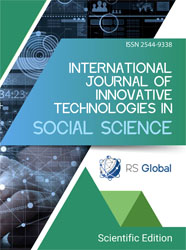A DIDACTIC SOLUTION FOR INTEGERS: A METHODOLOGICAL VARIANT WITH PRACTICAL DEMONSTRATION
Abstract
This study examines the effectiveness of using a symbol counter methodology to teach integer operations within a three-tiered didactic framework: concrete application, visual representation, and symbolic notation. The experimental approach was designed to address common student challenges, such as sign errors, incomplete understanding, and flawed reasoning in mathematical problem-solving. The pilot lesson incorporated student-centered teaching strategies, including hands-on activities, teamwork, discussion, and reflection.
The symbol counter, a tool utilizing physical symbols like paper circles with plus or minus signs, helped students grasp concepts such as positive and negative numbers, opposite numbers, and zero through tactile and visual experiences. This method facilitated a deeper understanding of integer properties and operations, including addition, subtraction, multiplication, and division. By transitioning from physical manipulation to mental visualization and symbolic abstraction, students were able to internalize mathematical concepts more effectively.
To validate the hypotheses proposed in the study, we explored the feasibility of employing methodological approaches that encourage student engagement in the lesson, critical thinking, self-directed learning, and collaboration. To achieve the established objectives, the following tasks were undertaken:
- Identifying the experimental group
- Creating the experimental lesson plan
- Conducting the experiment
- Evaluating the experimental outcomes
In high school math classes, we learned the rules for performing operations with integers. The sign calculations were written and formulated as follows:
- (+) × (+) = (+)
- (+) × (-) = (-)
- (-) × (+) = (-)
- (-) × (-) = (-)
These notations can be found in various textbooks and educational materials.
References
Batsuuri, Ts. Education for sustainable development: Lectures.
Doyod, U., & Dalaijamts, Ts. (2008). Methodology for supporting learning through learning activity evidence. Ulaanbaatar.
McKay, A., & Erdene, L. (2007). Mathematics - Grade 9 textbook. Ulaanbaatar.
Mathematics education standard (2005). Ulaanbaatar.
Mathematics education standard guidelines (2003). Ulaanbaatar.
Batsuuri, Ts. (2006). Issues in educational technology innovation (p. 13). Ulaanbaatar.
Ichinkhorloo, Sh. (2013). Learning theory and application: Foundations of general didactics. Ulaanbaatar.
Nyamjav, Ts., & Bunden, D. (2005). Mathematical didactics. Ulaanbaatar.
Adyaasuren, V., & Ariunzaya, G. (2011). Mathematics - Grade 9 textbook. Ulaanbaatar.
Mathematics Grade 6 (2013). Ulaanbaatar.
Mathematics Grade 9 (2016). Ulaanbaatar.
Mathematics Grade 10 (2013). Ulaanbaatar.
Mathematics Grade 11 (2013). Ulaanbaatar.
Mathematics Grade 12 (2015). Ulaanbaatar.
Mathematics Grade 5 (2016). Ulaanbaatar.
Mathematics and natural science didactics: Key issues, solutions, and approaches (2015). Ulaanbaatar.
Sandagdorj, B. Research on the origin and development of mathematics Olympiad and its problem system [Doctoral dissertation]. Ulaanbaatar.
Javzandulam, Sh., & Jugdernamjil, B. (2016). Guide to writing academic papers according to the "ARA" model. Ulaanbaatar.
Aman, S., & Oranshtai. (2001). Active learning strategies. Ulaanbaatar.
Kolmogorova, A. N., & Abramov, A. M. Algebra and beginning analysis Grades 9-10.
Bert Creemers, Leonidas Kyriakides, & Panayiotis Antoniou. Teacher development in improving teaching quality. London.
Leontieva, M. R., & Muravin, K. S. Didactic materials in algebra for Grade 6.
Robert A. Reiser, & John V. Dempsey. Instructional design and technology: Trends, issues, and approaches.
Menchinskaya, N. A. (1972). Psychological foundations of learning (p. 73).
Stolyar, A. A. (1981). Methods of mathematics teaching.
Ministry of Education, Culture, Science and Sports. (2013). Report on developing requirements and cost calculation methodology for digital learning objects used in general education school subjects (p. [page number]). Asian Development Bank.
Luvsandorj, Ts. & Munkhtaria, Kh. (2016). Integer fundamentals didactics. Ulaanbaatar.
Luvsandorj, Ts. & Munkhtaria, Kh. (2017). The art of teaching: Mathematics lesson demonstrations. Ulaanbaatar.
Luvsandorj, Ts. & Munkhtaria, Kh. (2017). Mathematics lesson demonstrations: Volume one. Ulaanbaatar.
Munkhtaria, Kh. & Luvsandorj, Ts. (2015). Natural number fundamentals didactics. Ulaanbaatar.
Illich, I. (1995). In the graveyard of the text: A Commentary to Hugh's Didascalicon. University of Chicago Press.
Luvsandorj, Ts. (2009). Towards reconsidering strategies for ensuring gender equality in education in the light of neuroscience: Either equality through difference or equality through sameness or neither 'through difference' nor 'through sameness’? Critical review. Retrieved from http://mr-institute.blogspot.com
Mäntylä, T. (2011). Didactical reconstructions for organizing knowledge in physics teacher education. Retrieved from http://ethesis.helsinki.fi/
Comenius, J. A., Locke, D., Rousseau, J.-J., & Pestalozzi, I. G. (1989). Pedagogical heritage (416 pp.). Pedagogy. (ISBN 5-7155-0164-4)
Wiley, D. A. Connecting learning objects to instructional design theory: A definition, a metaphor, and a taxonomy (pp. 22-24). Utah State University.
Views:
572
Downloads:
368
Copyright (c) 2025 Munkhtaria Khayankhyarvaa

This work is licensed under a Creative Commons Attribution 4.0 International License.
All articles are published in open-access and licensed under a Creative Commons Attribution 4.0 International License (CC BY 4.0). Hence, authors retain copyright to the content of the articles.
CC BY 4.0 License allows content to be copied, adapted, displayed, distributed, re-published or otherwise re-used for any purpose including for adaptation and commercial use provided the content is attributed.











